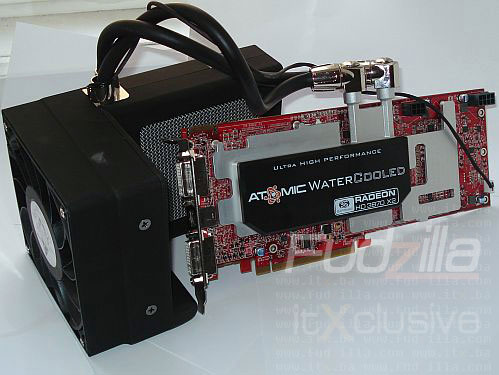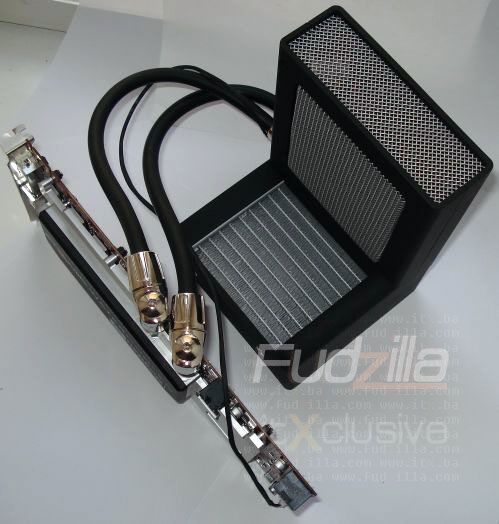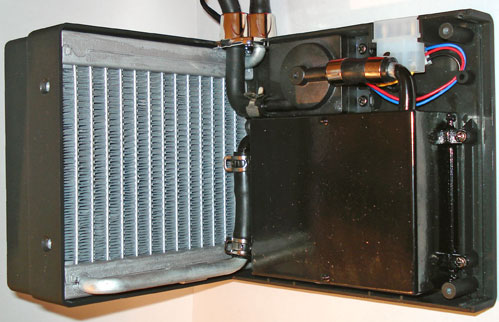
Review: Atomic cooler in action
We have mentioned Sapphire's Atomic series of graphics card many times, and we’ve even tested a couple. Atomic has become very popular since Sapphire decided to put a single slot cooler on one of the 3870 cards. They called it HD 3870 Atomic, and we’ve been charmed by its looks and quality. At the time, there was some talk that soon after HD 3870 X2 cards hit the market Sapphire would follow up with the Atomic version of HD 3870 X2. So, we expected a single slot card that would dump the reference dual slot cooler found on HD 3870 X2; but imagine our surprise when we heard that Atomic HD 3870 X2 will feature water cooling.
We received the first Atomic HD 3870 X2 sample in the last days of February, and we made a quick preview then. The opinions on this cooling solution varied, because the card ran at reference 825MHz and advantages of water blocks were a bit overshadowed by the noisy radiator fan. We couldn’t complain much since it’s an early specimen, but today we have a card that is more silent and runs at 864MHz.

Two R680 cores aren’t easy to cool, but Atomic's cooler can handle it with no trouble at all. To make sure of that, there‘s a huge block that stretches nearly the entire length of the card. The block covers the memory and power components on the front. The reference PCB wasn’t meddled with, but due to its 266mm x 112mm dimensions (W – H), you should make sure that it’ll fit your computer.
The water block appears tough safe, and features two heatpipes outlets on top. Maximum space between the card and the cooler box is about 30cm, but although it doesn’t leave many setting up options, it will be enough in most cases.

Although the card looks like single slot, it’s more of a slot-and-a-half, since it might get in the way of the card in the next slot. In most cases, the next slot is PCI or PCIe1x that’s probably free or has a smaller card that won’t cause trouble during Sapphire Atomic HD 3870 X2 mounting. A view from above shows that this is no dual slot card; a careful observer might notice that the water block’s width is greater than standard bracket width.

Two pipes start at the water block and lead to the radiator and the pump. You can individually rotate each pipe by more than 180 degrees, but with a little effort, you can put the cooling box virtually anywhere within 360 degrees.
Still, that won’t be necessary, since you can place the pump and the radiator above the card, whereas the most logical, and often the only possible, place will be next to the back panel of your motherboard – where the case fan is approximately the height of the CPU cooler. The pictures usually speak louder than words, so it’s best that you view the following three pictures.



During setting up your Sapphire HD 3870 X2 Atomic card, it’s more important to mind the fan size than to choose a big enough case. Any standard case that’ll house a 12cm fan will be wide enough for Atomic’s radiator/pump. The cooler shouldn’t be too high and it shouldn’t be too wide at the same time. Our CoolerMaster CM Sphere cooler with heatsink dimensions of 132 x 133 mm is probably the most you’ll be able to fit on the processor if you decide on this card.
The water block is cool during work, as opposed to reference card’s temperatures. While running in idle mode, the card’s temperature was around 53 degrees Celsius, only 4 degrees cooler than scored with reference card’s cooling. However, the good thing about water cooling is that there is very little difference between idle and workload temperatures, and in workload scenario, Sapphire cooling hit only 7 degrees Celsius more compared to idle temperatures. In such a scenario, we measured 82 degrees Celsius with reference cooling.

Good and effective cooling was a bit overshadowed by the lousy fan that ran pretty loudly, even noisier than reference HD 3870 X2 card’s fan. The picture above shows that RPM regulation is regulated through sensors placed on the card. A standard 4-pin pinhead used by reference cooling is still here, but the cable was extended and now leads directly to the radiator fan.

The cooling box has an L profile, and as we mentioned above, getting the right place to set it up within the case was quite difficult. The radiator and the fan are on one side, whereas the pump is hidden on the other.
We took the lid off and saw a well-packed system. The pump also needs power, supplied by a standard 4-pin molex. One pipe routes the hot water from the card to the pump that regulates circulation. After cooling in the radiator, the water goes back to cooling the card.

The reference card’s PCB connectors aren’t placed that well, and the same goes for Sapphire’s card. Although it’s not a dual slot card, once you connect the power cables, they’ll get in the way of the next card in line. Crossfire is possible, but using two Atomic HD 3870 X2 cards in one system will prove to be tricky to set up.
The card comes in a “case” that we’ve already seen in previous Atomic versions. We liked it the first time we saw it, and everything is nicely packed and Atomic-licious.

We tested an overclocked Sapphire HD 3870 X2 card running at 864MHz. The card is water-cooled and it runs 20°C cooler than reference card. We tried to overclock it, successfully, and it brought a 5% improvement in the games we tested. We managed to hit 905MHz core speed with memory at 2040MHz.
As we were not happy with the cooler noise we were playing with some other Radeon 3870 X2 bioses and we managed to make our card completely silent. We got the fan speed down, the card was still stable at over 900MHz overclocked speed and we finally got what we wanted. We are talking to Sapphire to make this bios public so you can make your card quiet.
Testbed:
Our testing system is not the one you’ve seen on the previous page, and it consists of:
Motherboard:
EVGA 680i SLI (Provided by EVGA)
Processor:
Intel Core 2 Duo 6800 Extreme edition (Provided by Intel)
Memory:
OCZ FlexXLC PC2 9200 5-5-5-18 (Provided by OCZ)
during testing CL5-5-5-15-CR2T 1066MHz at 2.2V
PSU:
OCZ Silencer 750 Quad Black ( Provided by OCZ)
Hard disk:
Seagate Barracuda 7200.9 80GB SATA (Provided by Seagate)
CPU-Cooler:
Freezer 7 Pro (Provided by Artic Cooling)
Case Fans:
Artic Cooling - Artic Fan 12 PWM
Artic Cooling - Artic Fan 8 PWM
Futuremark

Water-cooled Atomic HD 3870 X2 card didn’t score significantly better than reference HD 3870 X2 card, but it was the coolest card on our test.
Gaming

In Company of Heroes, the Atomic card outperformed Geforce 9800 GTX cards, but didn’t fare that well in the rest of the games. Antialiasing really brings Radeon’s scores down, and that’s even clearer in the next game.

Unlike Crysis, F.E.A.R. really liked the dual-chip card, and we ended up seeing some great performance scaling compared to a single HD 3870 card.

Conclusion
Once again, Sapphire proved that they’ve got what it takes and delivered an interesting product. Atomic is already a well-known and popular brand among enthusiasts, and the water-cooled HD 3870 X2 Atomic is simply unique among Radeons. You get the complete water cooling system made of the pump/radiator/reservoir, and the card is ready for some serious tasks straight out of the box.
Mounting the cooling box can prove to be somewhat of a problem in some of the smaller cases, but also depends on the other computer components, mostly the size of CPU coolers. Once you set it up, the Atomic card will surprise you. The core runs at least 20°C cooler than reference, and the card comes pre-overclocked to 864MHz.
The bad side of Atomic HD 3870 X2 is its noise, and it was louder than reference on plenty of occasions. Still, you can easily overclock it without worrying about overheating your GPU. Without modded bios we managed to solve this issue.
With 1GB of memory and two RV670 cores, this card can take anything you throw at it. The packaging is excellent, and you’ll get it in the best graphics card case we’ve ever seen.
The greatest downside to this card is probably the price, but if you want a card that's different, then Atomic HD 3870 X2 is more than a good choice. Sapphire’s reference design card is one of the cheapest HD 3870 X2 cards we’ve found, and it will set you back around €280, compared to the Atomic version that’s scarcely available at over €400.
